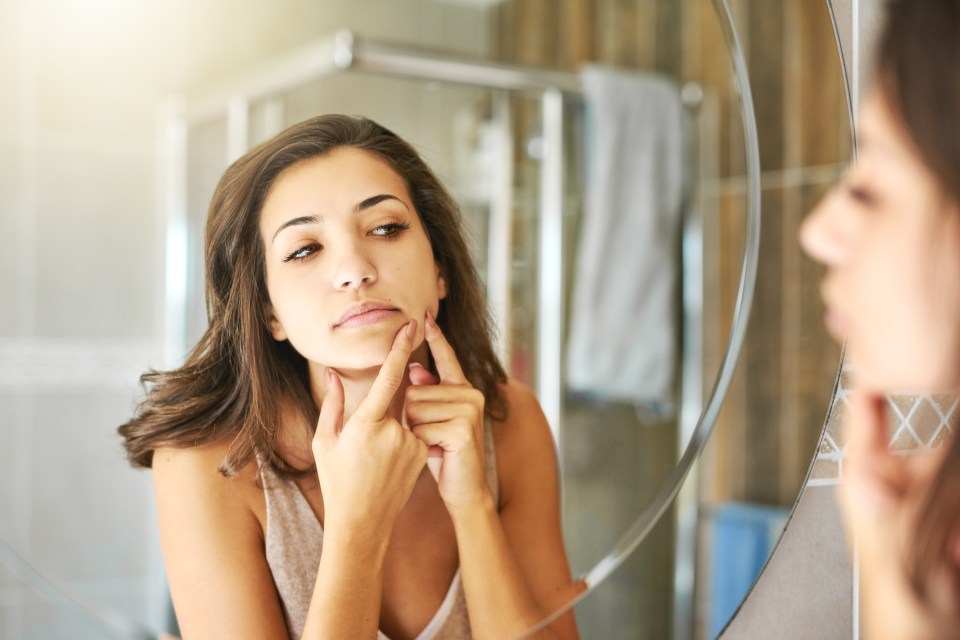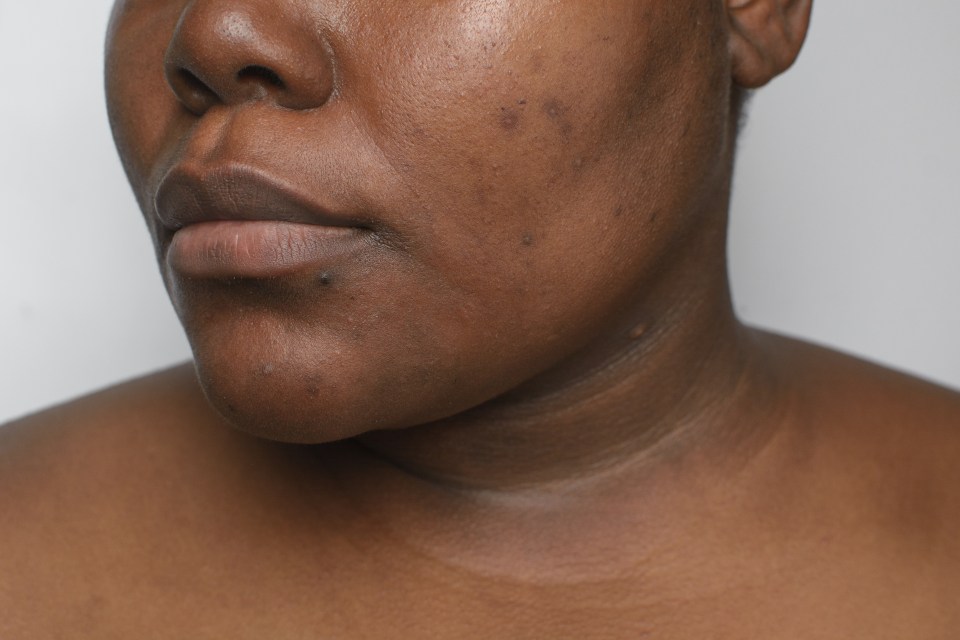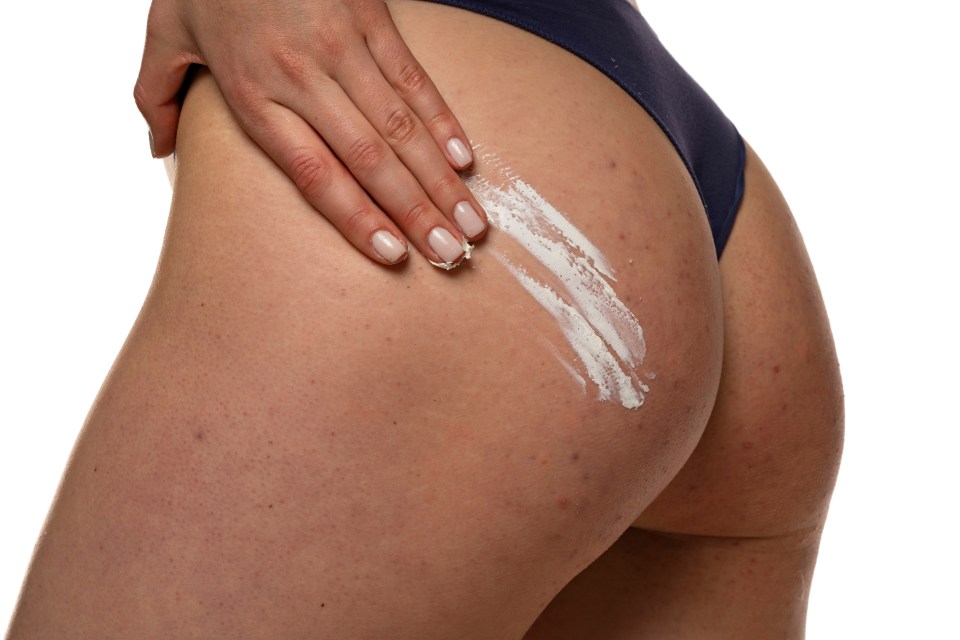SCARS, marks, spots and bumps are all on show on our skin.
Our skin can also act as a window into the inner workings of our bodies, revealing a lot about our overall health.
While blemishes and imperfections are normal, and nothing to be ashamed of, it’s important to take note of them.
More often than not they will be harmless conditions that require just a few tweaks or treatments to clear up.
Here, we look at how to lessen the appearance of those unwanted blemishes, rashes and pimples — and when you should see your GP.
HYPERPIGMENTATION
A NUMBER of skin complaints fall under hyperpigmentation, which is generally when an area of skin is darker than the rest.
Read More on Health
It’s the result of excess melanin production — melanin is what gives skin its colour.
For example, age spots are a reflection of sun exposure over many years.
They are generally harmless — though any area of skin, whether it be a mark, mole, lump or patch, that is growing fast, changing colour or shape should be checked for potential skin cancer.
Dr Munir Somji says that causes of pigmentation include pregnancy, the result of which is the so-called ‘mask of pregnancy’, with large patches of darkened skin.
Most read in Health
Diabetes can cause brown round or oval marks on the skin known as shin spots, medically called diabetic dermopathy.
People with medium to dark skin are more prone to hyperpigmentation and it may be harder to treat.
Lesley Reynolds of The Harley Street Skin Clinic, says: “Gentle exfoliation with acids such as lactic or mandelic acid, the use of skin-brightening ingredients like vitamin C and niacinamide, and diligent sun protection with broad-spectrum SPF are key.
“Consistency is essential and results may take longer to become noticeable compared to lighter skin tones.”
BUM PIMPLES
SMALL bumps on your butt cheeks could be folliculitis, according to Dr Somji, aesthetic doctor and founder of Dr Somji Skincare.
He says: “This is where the hair follicles become blocked with bacteria, leading to inflammation and appearing as red bumps/pus-filled follicles.
“Wearing tight-fitting clothing, such as gym wear, which holds sweat against the skin and blocks the hair follicles, not showering after exercise, or sitting for long periods in sweaty kit, can also contribute.”
To prevent bum pimples, opt for loose, breathable fabrics and shower as soon as possible after sweating.
Lesley adds: “Use a mild antibacterial soap or a body wash with benzoyl peroxide to reduce bacteria and gently exfoliate the area to prevent clogged pores.”
A spot treatment containing salicylic acid or tea tree oil can help treat bum pimples.
INGROWN HAIRS
GENERALLY in areas where people shave, ingrown hairs are typically harmless, though removing them the wrong way could cause problems.
There have been rare cases where ingrown hair removal has led to infection, and ultimately death.
Ingrown hairs occur when the hair curls back into the skin, causing irritation.
Dr Somji says: “If the follicles are clogged with dirt, debris and dead skin cells, this can also lead to ingrown hairs.
“Ensure you regularly exfoliate to prevent ingrown hairs, as this removes the dead skin cells that can trap them.”
You could also try letting the hair grow slightly longer before shaving.
You can pluck ingrown hairs with tweezers — but don’t aimlessly pluck, as you could end up piercing the skin, damaging the follicle and skin and potentially increasing the risk of infection and scarring.
Dr Somji suggests exfoliation and a warm compress on the area.
He says: “Once the hair comes through, you can then gently pluck it using sterile tweezers,” he says.
You should see a GP if an ingrown hair or area is painful, hot, swollen, or you feel hot, shivery, unwell or have a high temperature, the NHS warns.
STRAWBERRY LEGS
WHEN pores and hair follicles are clogged with trapped oil and dead skin cells, they can appear as black spots.
The spots — widespread and in a uniform pattern, usually on the legs — look similar to the black seeds on strawberries.
Those with coarse hair, dry or sensitive skin types and people who shave frequently may be more prone to strawberry legs.
Lesley explains that in order to minimise their appearance, exfoliate your skin two to three times a week with a gentle scrub.
She says: “For deeper exfoliation, products with salicylic acid or glycolic acid can help. Shave properly with a sharp razor and shaving cream.”
For those with persistent issues, laser hair removal may give long-lasting results and usually costs at least £150 for half legs, depending on the clinic.
Lesley also recommends a non-comedogenic moisturiser daily — that means one which does not clog the pores.
BLACKHEADS
TYPICALLY found on the nose, blackheads are small dark spots on the skin.
Lesley says: “They form when hair follicles become clogged with oil and dead skin cells, darkening as they are exposed to air.
“Avoiding heavy make-up can help prevent blackheads, as well as using non-comedogenic products.”
Non-comedogenic products (designed to minimise pore blockages) are ideal for those who are prone to blackheads, bumps or rough skin. Examples of ingredients are hyaluronic acid, squalane and zinc oxide.
Use a gentle cleanser morning and evening to remove oil and dirt, then apply an exfoliant that contains salicylic acid.
Lesley says: “For stubborn cases, consider a retinoid or professional extraction by a dermatologist.”
CELLULITE
AROUND nine in ten women will experience some form of cellulite on their thighs, butt and/or hips, according to a 2023 review of research by Canadian dermatologists.
Dr Somji says: “Cellulite occurs when fat pushes through weakened connective tissues in the skin, resulting in the familiar dimpling effect.
“It’s a myth that only overweight people can get cellulite as it can affect those of all shapes and sizes.”
There isn’t a cure for cellulite, no matter how many skin creams claim so, Dr Somji says.
“However, some ingredients might provide a temporary result.#
“These include caffeine, which tightens the skin, as well as retinol, which stimulates collagen production to also tighten the skin. Peptides also help to strengthen the skin.”
A healthy diet, along with exercise and strength training may help.
READ MORE SUN STORIES
Dr Somji adds: “An increase in your muscle mass can reduce the appearance of cellulite.
“Exercise also increases blood flow to areas of the body, resulting in fat loss and potential reduction of cellulite.”
The Importance of SPF

WITH summer finally here, here’s everything you need to know about SPF.
1. Protects Against UV Radiation:
- SPF shields your skin from harmful ultraviolet (UV) rays, specifically UVA and UVB rays, which can cause sunburn, premature aging, and increase the risk of skin cancer.
2. Reduces Risk of Skin Cancer:
- Regular use of SPF can significantly lower the risk of developing various types of skin cancer, including melanoma, which is the most dangerous form of skin cancer.
3. Prevents Premature Aging:
- UV exposure accelerates the aging process, leading to wrinkles, fine lines, and age spots. SPF helps maintain youthful skin by blocking these aging effects.
4. Maintains Even Skin Tone:
- Sun exposure can cause hyperpigmentation and uneven skin tone. Using SPF regularly can help prevent these issues, leading to a more even and radiant complexion.
5. Essential for All Skin Types:
- Regardless of skin type or tone, everyone is susceptible to UV damage. SPF is crucial for all skin types to maintain healthy skin and prevent damage.
6. Everyday Necessity:
- UV rays can penetrate through clouds and windows, making daily SPF application essential, even on cloudy days or when indoors.
This post was originally published on this site be sure to check out more of their content.









